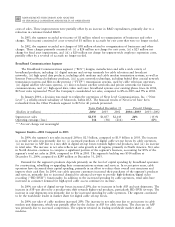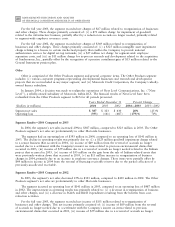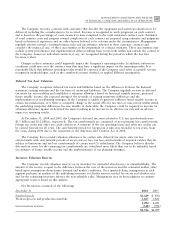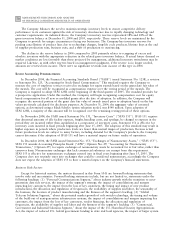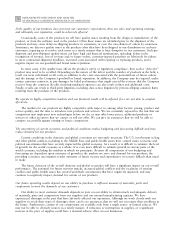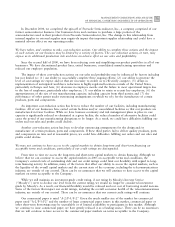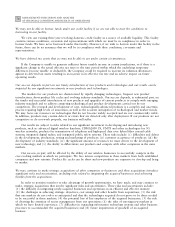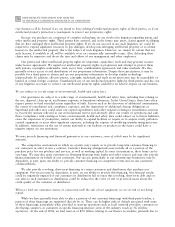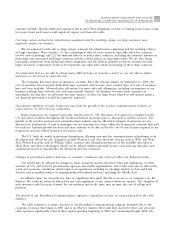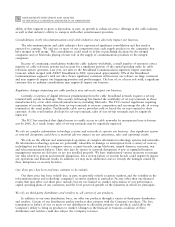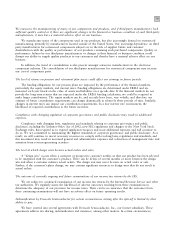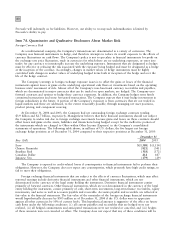Motorola 2004 Annual Report Download - page 80
Download and view the complete annual report
Please find page 80 of the 2004 Motorola annual report below. You can navigate through the pages in the report by either clicking on the pages listed below, or by using the keyword search tool below to find specific information within the annual report.
72 MANAGEMENT'S DISCUSSION AND ANALYSIS
OF FINANCIAL CONDITION AND RESULTS OF OPERATIONS
If the quality of our products does not meet our customers' expectations, then our sales and operating earnings,
and ultimately our reputation, could be adversely aÅected.
Occasionally, some of the products we sell have quality issues resulting from the design or manufacture of the
product, or from the software used in the product. Often these issues are identiÑed prior to the shipment of the
products and may cause delays in shipping products to customers, or even the cancellation of orders by customers.
Sometimes, we discover quality issues in the products after they have been shipped to our distributors or end-user
customers, requiring us to resolve such issues in a timely manner that is least disruptive to our customers. Such pre-
shipment and post-shipment quality issues can have legal and Ñnancial ramiÑcations, including: delays in the
recognition of revenue, loss of revenue and/or future orders, customer-imposed penalties on Motorola for failure
to meet contractual shipment deadlines, increased costs associated with repairing or replacing products, and a
negative impact on our goodwill and brand name reputation.
In some cases, if the quality issue aÅects the product's safety or regulatory compliance, then such a ""defective''
product may need to be recalled. Depending on the nature of the defect and the number of products in the Ñeld, a
recall can incur substantial recall costs, in addition to the costs associated with the potential loss of future orders,
and the damage to the Company's goodwill or brand/reputation. In addition, the Company may be required, under
certain customer contracts, to pay damages for failed performance that might exceed the revenue that the Company
receives from the contracts. Recalls involving regulatory agencies can also result in Ñnes and additional costs.
Finally, recalls can result in third-party litigation, including class action litigation by persons alleging common harm
resulting from the purchase of the products.
We operate in highly competitive markets and our Ñnancial results will be aÅected if we are not able to compete
eÅectively.
The markets for our products are highly competitive with respect to, among other factors: pricing, product and
service quality, and the time to introduce new products and services. We are constantly exposed to the risk that our
competitors may implement new technologies before we do, or may oÅer lower prices, additional products or
services or other incentives that we cannot or will not oÅer. We can give no assurances that we will be able to
compete successfully against existing or future competitors.
The uncertainty of current economic and political conditions makes budgeting and forecasting diÇcult and may
reduce demand for our products.
Current conditions in the domestic and global economies are extremely uncertain. The U.S. involvement in Iraq
and other global conÖicts, including in the Middle East, and public health issues have created many economic and
political uncertainties that have severely impacted the global economy. As a result, it is diÇcult to estimate the level
of growth for the world economy as a whole. It is even more diÇcult to estimate growth in various parts of the
world economy, including the markets in which we participate. Because all components of our budgeting and
forecasting are dependent upon estimates of growth in the markets we serve and demand for our products, the
prevailing economic uncertainties render estimates of future income and expenditures even more diÇcult than usual
to make.
The future direction of the overall domestic and global economies will have a signiÑcant impact on our overall
performance. The potential for future terrorist attacks, increased global conÖicts and the escalation of existing
conÖicts and public health issues has created worldwide uncertainties that have negatively impacted, and may
continue to negatively impact, demand for certain of our products.
Our future operating results depend on our ability to purchase a suÇcient amount of materials, parts and
components to meet the demands of our customers.
Our ability to meet customer demands depends, in part, on our ability to obtain timely and adequate delivery
of materials, parts and components from our suppliers and our internal manufacturing capacity. We have
experienced shortages in the past that have adversely aÅected our operations. Although we work closely with our
suppliers to avoid these types of shortages, there can be no assurances that we will not encounter these problems in
the future. Furthermore, certain of our components are available only from a single source or limited sources. We
may not be able to diversify sources in a timely manner. A reduction or interruption in supplies, or a signiÑcant
increase in the price of supplies could have a material adverse eÅect on our businesses.


